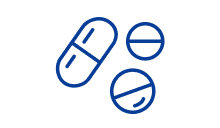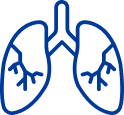
Sustainable Development & AMR
Antimicrobial resistance is a serious challenge to attaining the sustainable development goals and other health and development goals.
SDGs
The impact of antimicrobial resistance (AMR) hinders development across multiple sustainable development goals (SDGs), affecting not only public health (SDG 3) but also poverty (SDG 1), hunger (SDG 2), economic growth (SDG 8), and inequalities (SDG 10).
Evidence: The World Bank projects that 24 million people could fall into extreme poverty by 2030 because of antimicrobial resistance and its effect on increasing healthcare costs, reducing productivity, and threatening food security. (Source)
This message is reflected in the U.N. political declaration in PP1-2.

Economy
AMR imposes heavy economic burdens that will escalate if resistance is not tackled.
Evidence: The World Bank estimates that AMR could result in US$ 1 trillion in additional healthcare costs per year by 2050 and US$ 1 trillion to US$ 3.4 trillion in gross domestic product (GDP) losses per year by 2030. (Source)
This message is reflected in the U.N. political declaration in PP1, PP6.

One Health
Addressing AMR is intrinsically linked with improving human health, animal welfare, and safeguarding the environment.
Evidence: A package of One Health interventions can avert an estimated US$7.7 trillion in costs to our world between now and 2035. (Source)
This message is reflected in the U.N. political declaration in PP9, OP46.

Global Food Security
AMR threatens to increase food insecurity as it impedes our ability to treat sick livestock.
Evidence: AMR could reduce livestock production by up to 11%. (Source)
This message is reflected in the U.N. political declaration in PP1, PP6.

Health Systems
AMR causes significant collateral damage for health systems, including prolonged hospital admissions, increased healthcare costs, an overburdened public health system, higher costs in second-line drugs, increased treatment failures, and increased mortality rates.
Evidence: Healthcare systems are expected to spend approximately US$ 412 billion per year between 2015 and 2035 due to AMR. (Source)
This message is reflected in the U.N. political declaration in PP3, PP6, PP7, OP63.

Universal Health Coverage
Achieving universal health coverage and managing antimicrobial resistance go hand in hand. Access to affordable and effective antibiotics is a prerequisite to quality care, and access to quality care is integral to mitigating the spread and emergence of AMR.
Evidence: When formal primary care is missing, patients obtain antibiotics from pharmacists or lay providers, which can lead to overuse and misuse. (Source)
This message is reflected in the U.N. political declaration in PP3, PP8, OP42, OP63.

Pandemic Prevention, Preparedness, and Response
Widespread surveillance, access to diagnostic testing, and appropriate antibiotic treatment are essential for both effective pandemic prevention and response, as well as countering AMR.
Evidence: Access to microbiological laboratories is sorely lacking in many low-resource settings – of 50,000 medical laboratories in 14 African countries, only 1.3% conduct bacteriology testing, and even fewer can perform fungal diagnostics or AMR susceptibility testing. (Source)
This message is reflected in the U.N. political declaration in PP7.

Child Survival
Children and babies bear the highest burden of drug-resistant infections – AMR is one of the greatest threats to child survival and threatens to undermine the achievement of SDG 3.
Evidence: Mortality rates of newborns range from 4 times (high-income countries) to 160 times (Sub-Saharan Africa) higher in newborns than in older children and adults. (Source)
This message is reflected in the U.N. political declaration in PP5, PP14, OP61.

Cancer
AMR poses tremendous risk to advancements in cancer care by adversely affecting treatment outcomes and threatening the survival of people with cancer that rely on effective antibiotics.
Evidence: Bacterial infections are responsible for the hospitalization of 20% of the patients with cancer on treatment and a further 8.5% of the cancer deaths due to severe sepsis. (Source)
This message is reflected in the U.N. political declaration in OP20, OP60.

HIV/AIDS
Emerging resistance to HIV medicines is a serious concern in the fight against HIV/AIDS, posing a threat to the effectiveness of treatment and the potential for the spread of drug-resistant strains.
Evidence: All antiretroviral drugs, including those from newer drug classes, are at risk of becoming partially or fully inactive due to the emergence of drug-resistant virus strains. (Source)
This message is reflected in the U.N. political declaration in PP2, PP14, OP20, OP60.
Malaria
The spread of resistance to antimalarial medicines is a severe threat to control and eradication efforts, especially in places where health systems are fragile and malaria morbidity and mortality are highest.
Evidence: Partial resistance to artemisinin derivatives, the mainstays of malaria treatment, has been observed for two decades in South-East Asia, and more recently in Africa. (Source)
This message is reflected in the U.N. political declaration in PP2, OP60.

Tuberculosis
Drug-resistant and multi-drug resistant tuberculosis are signficant drivers of AMR-related deaths; resistance also makes tuberculosis (TB) treatment longer, more expensive, and less effective.
Evidence: About 29% of deaths caused by antimicrobial infections today are due to drug-resistant TB. (Source)
This message is reflected in the U.N. political declaration in PP2, PP14, OP20, OP59-60.